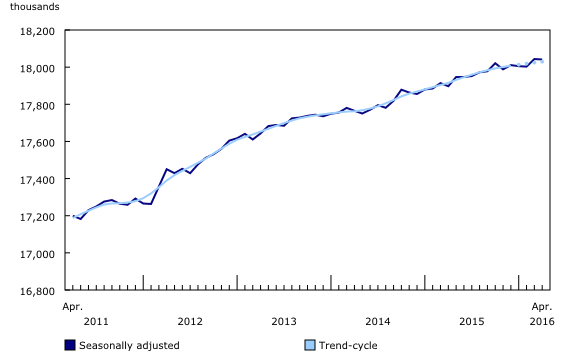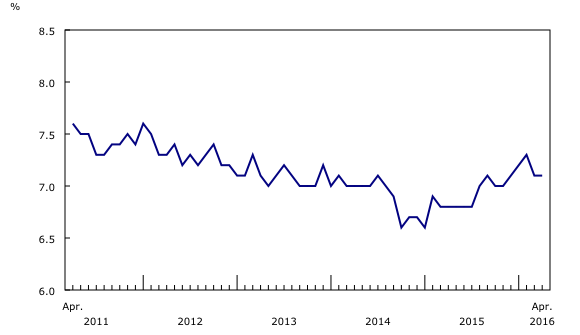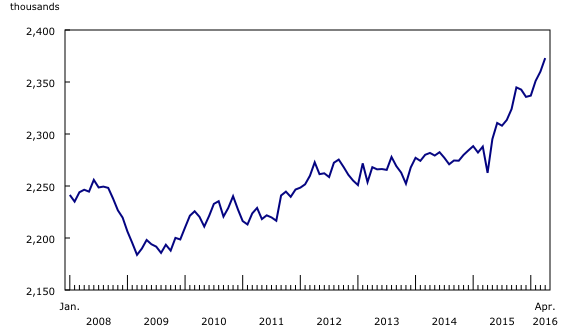Labour Force Survey, April 2016
Archived Content
Information identified as archived is provided for reference, research or recordkeeping purposes. It is not subject to the Government of Canada Web Standards and has not been altered or updated since it was archived. Please "contact us" to request a format other than those available.
Released: 2016-05-06
Following an increase in March, employment was virtually unchanged in April (-2,100 or 0.0%), and the unemployment rate remained at 7.1%.
Compared with 12 months earlier, employment increased by 144,000 or 0.8%, with gains in both full-time and part-time work. Over the same period, the number of hours worked rose by 0.9%.
In April, employment was little changed among the major demographic groups.
Provincially, employment declined in Alberta and Manitoba, while it increased in British Columbia, Newfoundland and Labrador, and New Brunswick.
There were fewer people working in manufacturing; business, building, and other support services; 'other services'; natural resources; and agriculture. These losses were offset by gains in wholesale and retail trade as well as accommodation and food services.
The number of self-employed workers edged down in April, while there was little change among public and private sector employees.
Little change among demographic groups in April
Employment for youths aged 15 to 24 was virtually unchanged in April, and their unemployment rate was 13.1%, little changed from both the previous month and 12 months earlier. On a year-over-year basis, employment for this group decreased by 43,000 (-1.7%). Over the same period, the youth population continued to decline (-46,000 or -1.0%).
For men aged 25 to 54, employment held steady on both a monthly and year-over-year basis, and the unemployment rate was little changed at 6.6% in April. However, their unemployment rate rose 0.6 percentage points compared with 12 months earlier, as more of them searched for work.
For women aged 25 to 54, employment was essentially unchanged in April, and their unemployment rate remained at 5.5%. On a year-over-year basis, employment for these women rose by 32,000 (+0.6%), while their unemployment rate increased by 0.3 percentage points, as more of them looked for work.
Employment for people aged 55 and older was little changed in April, and the unemployment rate was 6.2%, largely unchanged from both the previous month and 12 months earlier. On a year-over-year basis, employment gains for this group totalled 133,000 (+3.8%), continuing a long-term upward trend that has been driven by growth in the group's population (+309,000 or +3.0% from April 2015).
Employment down in Alberta, up in British Columbia
Employment in Alberta declined by 21,000 in April. However, the unemployment rate was little changed at 7.2%, as the number of people participating in the labour market also decreased. Compared with 12 months earlier, employment in the province was down 37,000 (-1.6%), and the unemployment rate rose 1.6 percentage points.
In Manitoba, employment fell by 3,000 in April, and the unemployment rate was mostly unchanged at 6.1%. Compared with April 2015, employment in the province was little changed, but the unemployment rate rose 0.6 percentage points as more people searched for work.
In April, employment increased by 13,000 in British Columbia, and the unemployment rate fell 0.7 percentage points to 5.8%—the lowest rate among the provinces. This is the first time that British Columbia has had the lowest unemployment rate among all the provinces since comparable data became available in 1976. On a year-over-year basis, employment in the province was up 110,000 (+4.9%). A strong upward trend was observed throughout the 12 months, driven by growth in wholesale and retail trade, health care and social assistance, and construction.
There were 6,100 more people working in Newfoundland and Labrador in April, and the unemployment rate edged down to 12.5%. Compared with 12 months earlier, the number of employed people and the unemployment rate were both virtually unchanged.
In April, employment in New Brunswick increased by 3,900, and the unemployment rate fell 0.6 percentage points to 9.6%. Despite the increase in April, employment for the province edged down on a year-over-year basis (-4,500 or -1.3%).
While employment was essentially unchanged in Ontario, an increase in the number of people searching for work pushed the unemployment rate up 0.2 percentage points to 7.0%. Compared with April 2015, employment gains for the province totalled 96,000 (+1.4%).
In Quebec, on both a month-to-month and year-over-year basis, employment was little changed and the unemployment rate was stable at 7.5%.
Industry perspective
Employment in manufacturing fell by 17,000 in April. Since December 2015, it has declined 52,000 (-3.0%), and about half of the losses occurred in Alberta. However, compared with April 2015, employment in this industry was little changed.
There were 16,000 fewer people working in business, building, and other support services in April. In the 12 months to April, the number of people working in this industry was unchanged.
In 'other services,' such as private household services offered by home child care providers, employment fell by 12,000. Compared with 12 months earlier, employment in this industry was little changed.
Employment in natural resources was down 7,800 in April, bringing total losses to 23,000 (-6.4%) on a year-over-year basis. Compared with its peak in April 2014, employment in this industry was down 50,000 (-12.9%), with most of the declines in Alberta.
In agriculture, employment was down 7,000 in April, but was little changed from 12 months earlier.
Employment increased by 27,000 in wholesale and retail trade, bringing total gains for the industry to 47,000 (+1.7%) on a year-over-year basis.
In accommodation and food services, employment rose by 22,000 in April, but was little changed compared with 12 months earlier.
The number of self-employed workers edged down in April and was virtually unchanged compared with 12 months earlier.
There was little change among public and private sector employees in the month. On a year-over-year basis, the number of private sector employees increased by 105,000 (+0.9%), while public sector employment was little changed.
Note to readers
The Labour Force Survey (LFS) estimates for April are for the week of April 10 to 16.
The LFS estimates are based on a sample and are therefore subject to sampling variability. As a result, monthly estimates will show more variability than trends observed over longer time periods. For more information, see "Interpreting Monthly Changes in Employment from the Labour Force Survey." Estimates for smaller geographic areas or industries also have more variability. For an explanation of sampling variability of estimates and how to use standard errors to assess this variability, consult the "Data quality" section of the publication Labour Force Information (71-001-X).
This analysis focuses on differences between estimates that are statistically significant at the 68% confidence level.
The LFS estimates are the first in a series of labour market indicators released by Statistics Canada, which includes indicators from programs such as the Survey of Payroll Employment, Earnings and Hours (SEPH), Employment Insurance statistics, and the Job Vacancy and Wage Survey. For more information on the conceptual differences between employment measures from the LFS and SEPH, refer to section 8 of the Guide to the Labour Force Survey (71-543-G).
The employment rate is the number of employed people as a percentage of the population aged 15 and older. The rate for a particular group (for example, youths aged 15 to 24) is the number employed in that group as a percentage of the population for that group.
The unemployment rate is the number of unemployed as a percentage of the labour force (employed and unemployed).
The participation rate is the number of employed and unemployed as a percentage of the population.
Seasonal adjustment
Unless otherwise stated, this release presents seasonally adjusted estimates, which facilitates comparisons by removing the effects of seasonal variations. For more information on seasonal adjustment, see Seasonally adjusted data – Frequently asked questions.
Chart 1 shows trend-cycle data on employment. These data represent a smoothed version of the seasonally adjusted time series, which provides information on longer-term movements, including changes in direction underlying the series. These data are available in CANSIM table 282-0087 for the national level employment series. For more information, see the StatCan Blog and Trend-cycle estimates – Frequently asked questions.
Next release
The next release of the LFS will be on June 10.
Products
A more detailed summary, Labour Force Information (71-001-X), is now available for the week ending April 16. From the Browse by key resource module of our website under Publications, choose All subjects, then Labour.
More information about the concepts and use of the Labour Force Survey is available online in the Guide to the Labour Force Survey (71-543-G), from the Browse by key resource module of our website, under Publications.
Contact information
For more information, contact us (toll-free 1-800-263-1136; 514-283-8300; STATCAN.infostats-infostats.STATCAN@canada.ca).
To enquire about the concepts, methods or data quality of this release, contact Andrew Fields (613-951-3551; andrew.fields@canada.ca) or Vincent Ferrao (613-951-4750; vincent.ferrao@canada.ca), Labour Statistics Division.
- Date modified:






